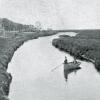Early efforts at preserving remains of HMS DeBraak
In 1985, salvagers used emerging sidescan sonar technology to sleuth out the location of the sunken HMS DeBraak off the point of Cape Henlopen. Divers confirmed what the sidescan sonar showed and efforts began to not only track down the gold long purported to have gone down with the British warship but also one of the most significant troves of maritime paraphernalia from the late 1700s ever discovered.
This photograph shows an archaeologist at work inside the remains of the hull of the vessel which was hoisted by cranes aboard a barge. Evident are the supplies of cannonballs that served as ballast and ammunition. Delaware's Division of Historical and Cultural Affairs has a warehouse filled with items retrieved from the DeBraak and the hull remains are still submerged to keep them from deteriorating further. The amount of treasure retrieved from the vessel - as far as is publicly known - never approached the levels that legend said were aboard the vessel.
The DeBraak sank in a sudden squall in the spring of 1798, drowning more than 30 crew members. Capt. James Drew's remains were eventually recovered and buried in the churchyard of St. Peter's Episcopal Church in Lewes.

























































